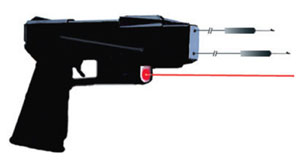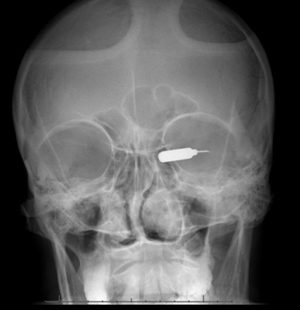Theodore Leng, MD
Contributing Editor
The TASER is a line of projectile non-lethal weapons manufactured by TASER International, Inc. in Scottsdale, Arizona. These pistol-like weapons fire two dart-like projectiles on a 25 ft copper wire at 160 ft/sec. The darts are 5.5 mm long, 1 mm wide, and have a 4 mm fish hook barb. They are able to penetrate up to 2 inches of clothing and cause tonic-clonic contractions of skeletal muscles, pain, and exhaustion by transmitting 50,000 volts of electricity from 8 AA batteries in 5-30 pulses/sec. Fortunately, this technology leaves smooth and cardiac muscle unaffected, so the target will not lose respiratory or cardiac function.
 Figure 1. Cartoon depicting a TASER device with 2 projectile darts and a laser aiming system
Figure 1. Cartoon depicting a TASER device with 2 projectile darts and a laser aiming system

Figure 2. The X26 law-enforcement model of the TASER device.
The TASER devices have been very successful in reducing the number of injuries to both law enforcement personnel, as well as the suspects that these devices are typically deployed on. Due to the devices’ success, over 120,000 have been sold in the past 10 years and are in use by over 5,500 police departments in the United States.
Multiple recent police department reports confirm the reduction in suspect and law enforcement personnel injury. The Chico, CA police department reported that only 2% of TASER suspects were injured compared to 79% of suspects who were batoned and 53% of suspects who were physically taken down. From 2002 to 2004, the Cape Coral, FL police department reported a 93% reduction in officer injuries and a 68% reduction in suspect injuries after TASER use began.
Even though injury rates have significantly decreased since the introduction of TASER devices, facial and ocular injuries have been reported. An article in the Annals of Emergency Medicine in 1987 (Vol 16, pp. 73-78) found that the projectile darts from the TASER device hits the face about 1% of the time.
There are 3 articles in the literature reporting on ocular injuries from TASER devices. in 2005 the American Journal of Ophthalmology published a case report (Vol 139, pp. 713-715) of a 50 year-old man who was shot by a TASER dart through his right lower eyelid that resulted in a ruptured globe injury. There was a second ruptured globe injury reported in Clinical and Experimental Ophthalmology in 2006 (Vol 34, pp. 378-380) of a 21 year-old man who was shot directly in the globe by a TASER dart. Lastly, in 2007 a case was reported in the Journal of Cataract and Refractive Surgery (Vol 33, pp. 1664-1665) of a cataract caused by the electrical discharge from a TASER dart.
Case Report
In 2008, a 49 year-old Hispanic male inmate presented to our ocular emergency room having been injured in his left orbit by a TASER dart after an altercation at his facility. This patient had previously been enucleated in his left eye. The dart had penetrated his left upper eyelid and entered the orbital implant.
 Figure 3. External photograph of the patient after injury to the left upper eyelid and orbital prosthesis with a TASER dart.
Figure 3. External photograph of the patient after injury to the left upper eyelid and orbital prosthesis with a TASER dart.

Figure 4. External photograph of the patient after injury to the left upper eyelid and orbital prosthesis with a TASER dart.
X-rays and a CT scan confirmed the location of the TASER dart’s fish hook barb in the orbital implant.
 Figure 5. X-ray showing the TASER dart in the left orbit.
Figure 5. X-ray showing the TASER dart in the left orbit.

Figure 6.
Axial CT scan showing the tip of the TASER barb in the orbital implant.
The dart was firmly embedded in the patient’s orbital implant and was motile on his motility exam.
Video 1. Motility exam of patient with TASER dart impaled in his left orbital implant.
The patient was taken to the operating room where the TASER dart was removed from his orbit under direct visualization and with a slow and steady application of force. The eyelid laceration was subsequently repaired and the patient recovered without complication.
 Figure 7. Intraoperative photograph (surgeon’s view) of the TASER dart after removal and the entrance wound in the left upper eyelid.
Figure 7. Intraoperative photograph (surgeon’s view) of the TASER dart after removal and the entrance wound in the left upper eyelid.
Conclusion
The advent of TASER devices has significantly reduced the number of law enforcement personnel and suspect injuries. While facial injuries are rare with these devices, the result of an ocular injury is usually a ruptured globe. Fortunately in this case, the patient did not lose any ocular function because he had been previously enucleated. Furthermore, the patient made a full recovery without the need to replace his orbital implant.
Have a question or comment on this article? Use the "Comment" link above to leave your thoughts, and the author will respond.